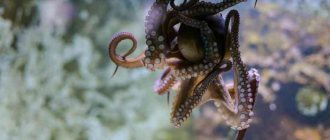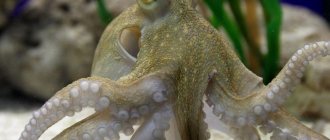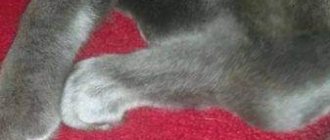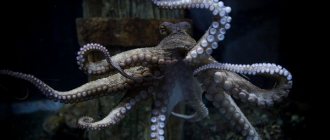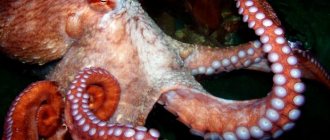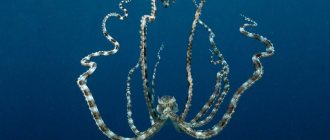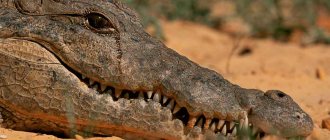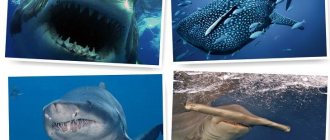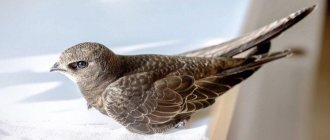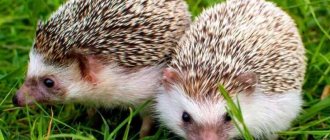- Wild animals
- >>
- Other animals
Octopus is a well-known cephalopod, distributed in almost all seas and oceans. These amazing animals can take on different shapes and colors, camouflaging themselves with their surroundings. Octopuses are valued among people due to their taste, which is why today there are entire farms for breeding these animals.
Origin of the species and description
Photo: Octopus
Octopuses (aka octopuses) are the most common representatives of the cephalopod order. Theutologists, scientists who study octopuses, distinguish two main orders that differ in their way of life: benthic and nomadic. For the most part, octopuses are bottom-dwelling creatures.
The body of an octopus consists entirely of soft tissue, therefore, in terms of paleontology, research on the origin of octopuses is difficult - after death, they immediately decompose, leaving no traces in the layer. However, European paleontologists discovered the remains of an octopus imprinted in the once soft soil rocks in Lebanon.
Video: Octopus
These traces were left approximately 95 million years ago. The remains of these octopuses are in no way different from modern octopuses - the prints were accurate, right down to the structure of the stomach. There are also other types of fossil octopuses, but the sensational discovery revealed that octopuses have not changed over millions of years of existence.
The following representatives also belong to the order of cephalopods:
- nautiluses;
- cuttlefish;
- squid.
Interesting fact: Squids are the largest representatives of cephalopods. In 2007, a female colossal squid was caught that weighed about 500 kg.
The name “cephalopod” was not obtained by chance: several (usually eight) tentacle limbs grow from the head of a representative of the order. It is also common that cephalopods do not have chitinous shells or have a very thin chitinous coating, which in no way protects them from external influences.
Using a word in a different meaning
This word is associated not only with the world of biology. "Octopus" is the title of a film about the Italian mafia. The film has 48 episodes and was filmed from 1984 to 2001. Famous Italian actor Michele Placido starred in the title role of Commissioner Corrado Cattani.
Several models of the Russian anti-tank gun, as well as a control and navigation point (Russia), bear the name “Sprut”.
In addition, the word “octopus” also has a figurative meaning - “greedy monster.”
After reading the article, you will probably not be confused if you are asked who or what an octopus is, but will be able to answer this question in detail.
Appearance and features
Photo: Giant octopus
Octopuses are made entirely of soft tissue. Its “head” has an oval shape, from which eight movable tentacles grow. The mouth with jaws that resemble the beak of a bird is located at the point where all the tentacles converge - the octopuses grab the victim and pull it into its center. The anus is located under the mantle, a leathery sac behind the squid.
The octopus's pharynx is ribbed, called the “radula,” and functions as a grater for food. The octopus' tentacles are connected by a thin, stretchy membrane. Depending on the size of the octopus, its tentacles may have one or three rows of suckers. An adult octopus has a total of about 2 thousand suckers, each of which can hold about 100 grams of weight.
Interesting fact: Octopus suction cups do not work like man-made suction cups - in a vacuum. The octopus attaches itself using muscle effort.
The octopus is also interesting because it has three hearts. The first drives blood throughout the body, and the other two hearts act as gills, pushing blood through for respiration. Some species of octopus have poison, and blue-ringed octopuses, which live on the Pacific coast, are ranked among the most poisonous animals in the world.
Fun fact: Octopuses have blue blood.
Octopuses have absolutely no bones or any kind of frame, which allows them to freely change shape. They can spread out along the bottom and disguise themselves as sand, or they can climb into the neck of a bottle or a narrow crevice in the rocks. Octopuses are also capable of changing their color to suit their environment.
Octopuses vary in size. The smallest representatives can reach a length of 1 cm, the largest - (Doflein's octopus) - 960 cm with a mass of 270 kg.
Links[edit]
- Cosgrove, James; McDaniel, Neil (2009). Super Suckers: The Giant Pacific Octopus and Other Pacific Coast Cephalopods
. Harbor Publishing. ISBN 9781550174663. - ^ ab He is grateful, K. L. (2008). "Aerobic metabolism and dietary ecology of Octopus rubescens" (PDF). (2.4 MB) . M. Sc. Walla Walla University, College Place, WA: 91
- ^ abc Hochberg, F. G. (1997). Octopus rubescens
. Proceedings of a workshop on fisheries and market potential for octopus in California. Smithsonian Institution (Washington, DC). - Jump up
↑ Hochberg, F. G. (1998).
Octopus rubescens
.
In: P. W. Scott and J. A. Blake (eds.) Taxonomic atlas of the benthic fauna of the Santa Maria Basin and western Santa Barbara Sound: Vol.
8 . (pp. 213–218). Santa Barbara, California, Santa Barbara Museum of Natural History. - Berry, S.S. 1953. Preliminary diagnoses of six Western American species of octopus
.
Malacology Leaflets 1
: 51–58. - ^ a b Dorsey, E.M. (1976). Natural history and social behavior of Octopus rubescens
(Berry). M. Sc. University of Washington, Seattle, WA: 44. - Jump up
↑ Anderson, R. C. (2006).
"Octopuses on the West Coast, including a field key to West Coast species." The Festivus 38
(1):5–6. - Jump up
↑ Mather, J. A. & R. C. Anderson (1993).
"Personalities of Octopuses ( Octopus rubescens
)".
Journal of Comparative Psychology 107
(3): 336–340. - Jump up
↑ Anderson, R. C., P. D. Hughes, J. A. Mather & C. W. Steele (1999).
"Determining the diet of Octopus rubescens by
examining its beer bottles in Puget Sound."
Malacology 41
(2):455–460. - Laidig, T. E., Adams, P. B., Baxter, CH, & Butler, J. L. (1995). Diet of the euphausiid Octopus rubescens
.
California Fish and Game Technical Report 81
(2):77–79. - Warren, L. R., Scheier, M. F. & Riley, D. A. (1974). Color changes in Octopus rubescens
when attacked by unconditioned and conditioned stimuli.
Animal Behavior 22
(1):211–219. DOI: 10.1016/S0003-3472 (74) 80071-0 - Jump up
↑ Anderson, R. C., Sinn, D. L. & Mather, J. A. (2008).
"Location of drilling for the bivalves Octopus rubescens Berry, 1953 (Cephalopoda: Octopodidae)" (PDF). Veliger 50
(4):326–328. - Onthank, K. L., & Cowley, D. L. (2011). Prey selection in Octopus rubescens
: possible roles in energy balance and nutritional composition of prey.
Marine Biology 158
(12):2795–2804. DOI: 10.1007/s00227-011-1778-4
Where does the octopus live?
Photo: Octopus in the sea
They can be found in the warm waters of seas and oceans at various depths.
Octopuses choose the following places for comfortable settlement:
- deep bottom, where it comfortably disguises itself as stones and sand;
- sunken objects with many secluded places;
- reefs;
- rocks.
Octopuses hide in small crevices and secluded places, and can also hunt there. Sometimes an octopus can climb into a shell left by crustaceans and sit there, but octopuses themselves never establish permanent homes.
The maximum depth at which octopuses can comfortably live is 150 m, although deep-sea representatives of the genus can descend 5 thousand meters down, like squid. Occasionally, octopuses can be found in cold waters, where they behave extremely sleepy.
They are considered to be nocturnal creatures, since during the daytime they hide in their shelters. Occasionally, being half asleep, an octopus can grab prey swimming by and, almost without waking up, eat it.
Octopuses can swim, although they don't like to do so - swimming creates a vulnerable situation where the octopus is easy to grab. Therefore, they move along the bottom using tentacles. There are no obstacles for octopuses in the form of steep rocks and vertical surfaces - the octopus makes its way along them using suction cups and grabbing onto any objects with its tentacles.
When swimming, they move slowly because they use the cuttlefish method: they take water into their mouth and push it out. Due to their slowness, they mostly hide in shelters and move when absolutely necessary.
Geographic nicknames
Octopuses are inhabitants of the depths of the sea, coral reefs, and warm tropical shallow waters. These creatures are found off the coasts of several continents. The names of coastal countries, cities and natural objects can make an excellent name for an octopus toy, which will emphasize the exoticism of this animal.
For girls:
- Alanya;
- Argentina;
- Bahia;
- Bayonne;
- Benguela;
- Venezuela;
- Vitoria;
- Havana;
- Gambia;
- Greece;
- Jebinyan;
- Casablanca;
- Catania;
- Cuba;
- Kunene;
- Luanda;
- Malta;
- Misurata;
- Palm;
- Ravenna;
- Rocha;
- Ceara;
- Tenerife;
- Tripoli.
For boys:
- Bokeh;
- Gibraltar;
- Dakar;
- Delaware;
- Hierro;
- Izmir;
- Cagliari;
- Cancun;
- Karas;
- Cape Town;
- Kemer;
- Cyprus;
- Crete;
- Livorno;
- Lorient;
- Marmaris;
- Morocco;
- Naples;
- Palermo;
- Pesaro;
- Rhodes;
- Salvador;
- Salerno;
- San Sebastian;
- San Jose;
- Sfax;
- Thies;
- Tombois;
- Tunisia;
- Erongo.
What does an octopus eat?
Photo: Big octopus
Octopuses are convinced predators that are capable of swallowing almost any prey, even those larger than themselves. A hungry octopus waits patiently in a secluded place, changing its color to camouflage. When prey swims by, it makes a sharp lunge, trying to grab it with all its tentacles at once.
Speed is very important in this matter - a strong opponent can break free of his grip. Therefore, the octopus immediately pulls the prey into its mouth. Its beak bites the victim if it does not fit into the mouth, and the pharynx performs a chewing function - it crushes food into small pieces.
Interesting fact: Poisonous octopuses extremely rarely use poison to kill prey - this is more of a defense mechanism than an adaptation for hunting.
Most often, octopuses feed on the following representatives of the ocean fauna:
- any fish, including poisonous ones;
- crustaceans, which sometimes give serious resistance to octopuses;
- the octopus's favorite delicacy is lobsters, lobsters and crayfish, which, upon seeing a formidable predator, strive to swim away from it as quickly as possible;
- sometimes large octopuses can catch a small shark;
- Cannibalism is not a rare phenomenon among octopuses. Stronger individuals often eat smaller ones.
There are times when an octopus does not calculate its strength when attacking a particular victim, or a predatory fish itself tries to eat the octopus. Then a fight ensues, in which the octopus may lose a tentacle. But octopuses are weakly susceptible to pain, and their tentacles grow quickly.
Features of character and lifestyle
Photo: Sea octopus
Octopuses are dedicated loners, very attached to their territory. They lead a sluggish, sedentary lifestyle, running from place to place only when necessary: when there is not enough food in the old territory, when enemies have appeared around, or when they are looking for a partner.
Octopuses consider each other competitors, so one octopus tries to avoid the territory in which another octopus lives. If a collision does occur and the trespasser is in no hurry to leave, a fight may occur in which one octopus risks being injured or eaten. But such collisions are extremely rare.
During the day, octopuses hide in a shelter, and at night they go out into more open spaces to hunt. Octopuses like to choose various traces of human activity as a home: boxes, bottles, car tires, etc. They live in such houses for a long time. There is cleanliness around the octopus's house: they remove excess debris and dead algae, as if sweeping the surroundings with a stream of water. They put leftovers and garbage in a separate pile.
In the winter, octopuses descend to the depths, in the summer they live in shallow water, and they can sometimes be found on the shore - octopuses are often thrown out by waves.
Social structure and reproduction
Photo: Little octopus
Twice a year, the female begins to look for a male to mate with. They form a strong couple and find a home together, which they arrange in such a way that it is comfortable to keep an eye on the eggs. Typically, such housing is located in shallow waters.
Octopuses do not have courtship and fights for a female. The female herself chooses the male with whom she wants to have offspring: due to her lazy lifestyle, this is usually the closest male she can find.
The female lays about 80 thousand eggs. She stays with the offspring and zealously protects the clutch. The incubation period lasts 4-5 months, during which the female does not go out hunting, becomes completely exhausted and, as a rule, dies from exhaustion by the time her children appear. The male also takes part in the life of future children, protecting the female and eggs, as well as removing dirt and all kinds of debris from them.
After emergence, the larvae are left to their own devices; for the first two months they eat plankton and swim with the current. Thus, they often become food for cetaceans that feed on plankton. At two months the larva becomes an adult and begins to lead a bottom-dwelling lifestyle. Rapid growth allows many individuals to survive. At the age of four months, an individual octopus can weigh 1-2 kilograms. In total, octopuses live 1-2 years, males live up to 4 years.
Taxonomy[edit]
In the years leading up to the species' description in 1953, O. rubescens
was widely considered to be a juvenile
Enteroctopus dofleini
.
Many early descriptions were based on a combination of O. rubescens
and
E. dofleini
.
[3] [4] To date, the taxonomy of this species remains unresolved. S. S. Berry's description in 1953 is actually a summary diagnosis [5], and given the exceptionally wide range of species, the animals currently falling under O. rubescens
may represent multiple subspecies or a species complex.
Natural enemies of the octopus
Photo: Octopus
Among the natural enemies of the octopus, we can distinguish those who pose the greatest danger to it:
- sharks, including reef sharks;
- seals, sea lions and fur seals;
- dolphins and killer whales often play with octopuses, eventually eating them or leaving them alive;
- some large fish.
If an octopus is found by a predator in a state of secrecy, the first thing it will do is try to swim away. Many species release clouds of ink at the enemy and then swim away - this is how the octopus buys time until the enemy sees it or is in a state of shock. Also, for the purpose of self-preservation, octopuses hide in narrow crevices and wait until the enemy leaves.
Another unique way of protecting the octopus is autotomy. When the enemy grabs the creature by the tentacle, the octopus deliberately detaches it from the body and flees. This is similar to how a lizard sheds its tail if it is grabbed by it. The tentacle subsequently grows back.
Interesting fact: Some octopuses have been observed engaging in autocannibalism—eating their own tentacles. This is due to a disease of the nervous system, in which the octopus, experiencing the slightest hunger, eats the first thing that, literally, “comes to hand.”
Scientists believe that octopuses are the most intelligent species of invertebrates. They show intelligence and observation in all kinds of experiments. For example, octopuses can open jars and primitive latches; Individual octopuses are able to put cubes and circles into certain holes that match in shape. The high intelligence of these creatures makes them rare prey for marine life, most of which do not have this indicator.
Ancient legends about krakens
In 1811, an English corvette almost died as a result of an encounter with a kraken. The ship left Valparaiso and was heading to the shores of America. About halfway to its destination, the corvette crashed into a giant octopus at full speed. The Kraken surfaced literally a few fathoms from the ship, leaving the crew no opportunity to get around the obstacle that had arisen. It seemed to the sailors that a real island had surfaced, about 180 meters in diameter and almost six meters in height.
The “island” turned out to be fragile; the corvette easily cut through it. Immediately after this, the sailors began to have seizures - loss of consciousness, bleeding from the mouth and nose, vomiting and headache. Many were thrown overboard, and about a quarter of the crew (including captain Elton Withersmith) died of apoplexy. But if the giant octopus (the sailors had no doubt that it was a kraken) had not plunged into the abyss, the consequences could have been more tragic. Apparently, not only the tentacles of the giant octopus pose a threat to humans.
It is known that the structure of the squid allows the animal to release “ink” - a protective liquid that facilitates unnoticed escape from enemies. But the protective fluid of the giant octopus - the kraken - is very poisonous...
There are incredible legends about krakens, according to which the size of sea animals can reach 2 km in circumference. Such krakens look like a cluster of small islands (with one - the only difference - very tenacious tentacles). No matter how you remember the adventures of Sinbad the Sailor! The two-kilometer-long giant octopus poses a considerable danger - when the animal dives, a giant funnel is formed that can pull even a large ship to the bottom. However, even in the Middle Ages, science considered it impossible for krakens of this size to exist.
In many countries, the story of the Indian schooner “Pal” is known, which in the spring of 1874 sailed from Ceylon to the shores of Burma. Of the entire crew, only a few sailors survived, who were taken home by the Stetowen steamer. According to those rescued, the schooner was drifting when a huge mass, similar to a giant octopus, slowly emerged from the water. This animal or object, resembling an octopus in its structure, began to jerkily approach the schooner. The monster dealt her a terrible blow, causing the schooner to rock. At the same moment, several tentacles entwined the ship, and the animal began to crawl onto the deck. A giant octopus grabbed the mast, capsized and sank the schooner.
It is believed that krakens live at a depth of 200 - 1000 meters and guard the treasures of sunken ships. This explains such rare encounters between sea monsters and people...
The name "kraken" was given to the giant octopus by fishermen in Northern Europe. Legends about these sea monsters originated in Viking times. Even these fearless warriors remembered with horror the battles with supernatural creatures with the tentacles of an octopus and the body of a whale. Marine legends of Scandinavia contain references to these mysterious inhabitants of deep waters.
In 1896, the remains of a giant octopus were found, washed ashore by the tide. The body of a sea monster was discovered on the coast of the town of St. Augustine, located in Florida. The length of the “kraken” was almost 30 meters.
